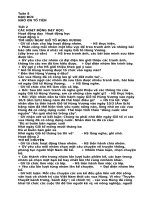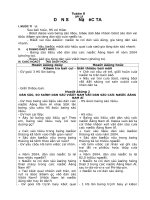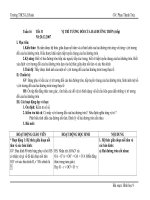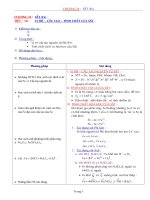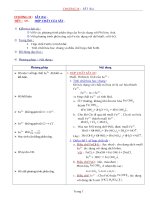Unti 9 ( 5 tiet)
Bạn đang xem bản rút gọn của tài liệu. Xem và tải ngay bản đầy đủ của tài liệu tại đây (147.29 KB, 10 trang )
Unit 9: UNDERSEA WORLD
Period 55 : A- Reading
Aims: - introduce some new words and phrases
- practise reading the passage and getting information
from it.
- Get to know about the undersea world and the sea
population.
Methods: Communicative approach
Teaching aids: textbooks, newspapers, magazines, pictures of sea and
plants animals……
Process:
TEACHER’S ACTIVITIES STUDENTS’ ACTIVITIES
I. Warmers
Ask sts the question:
Look at the map of the world and give the
Vietnamese names for the oceans in the
world
II. New lesson:
Introduce the lesson in general: Today we are
discussing the life of the undersea world in
order to understand more about how the
creatives live.
Ask sts to read the passage quickly.
Give sts the new words that can affect to sts’
understanding.
1. New words:
Ocean = sea
Gulf = Bay
Cover
Challenge
Mystery
Submarine
Investigate
Marine life
Satellite photograph
Include
Think of the questions, can discuss.
The answers may vary.
Listen to the teacher, discuss with
friends about the undersea world.
Read the passage, try to get
information from that.
Write down and learn how to
pronounce the new words.
Read the passage again. Guess the
answer for task 1.
Water current
Teach sts to pronounce the words.
Ask sts to read the passage again, this time
carefully.
Ask them to do the tasks.
1. Task1:
Give them time to practise. Then call them to
give out the answers. Give feedback.
*. Answers:
1. tiny 2.investigate
3. gulf 4.biodiversity 5.samples
Ask sts to explain the meaning for the words
in Vietnamese.
2. Task 2:
Ask sts to read the passages again.
Give them time to discuss in pairs.
Call some sts to give the answers and their
explanation.
Give feedback:
1. about 75 %
2. they use modern devices
3. submarines are sent to investigate the
seabed and bring samples of marines life
back to the surface for further study.
4. we can know the temperature, depth, and
the undersea populations.
5. they are swimming animals, tiny organism,
and those which live on or depend on the
bottom.
6. marine life would be at stake.
III. Consolidation:
Summarize the lesson, focus on main ideas.
IV. Homework:
Prepare the lesson at home.
Explain the meaning of the words in
task 1, can explain in English or in
Vietnamese.
Read the request of the task, make
sure you understand what you have
to do.
Work in pairs, find out the answers.
Give out the answers in front of the
class, others listen and give
comment.
Read the passages carefully again.
Discuss with friends to answer
them.
Can exchange the answers with
friends.
Use the feedback to check
yourselves.
Free talking.
Unit 9: UNDERSEA WORLD
Period : 56
Part B : Speaking
Aims : - practise speaking in English about topics given
- Practise expressing your own idea about some things.
Methods : Communicative approach
Teaching aids: textbook, pictures, visual objects….
Process :
TEACHER’S ACTIVITIES STUDENTS’ ACTIVITIES
I. warm- up:
Give them some questions in order to lead them
to the topic of the lesson
Name the oceans in the world.
II. New lesson:
Introduce the main topic of the lesson, as well as
the tasks of it.
The lesson will ask you to get to know more about
how to protect the sea environment, and talk about
them.
1. Task 1: Below are some actions that should be
taken to protect our oceans. Put in the order of
importance and then say what we should or should
not do.
Help sts to understand the situation and the task
they are sharing.
Give sts time to discuss and give the answers.
Explain the new words if necessary.
Call them to answer.
Should encourage sts to give the reason for the
order they choose.
Ex: I think that action (f) is the most important
because if we learn all we can bout the oceans we
will understand their values and try to protect
them.
Discuss and then give out the
answers..
Listen to the teacher, can ask for
general information relate to the
topic.
Study the task and its request. Try
to do the task by working with a
friend, then take note.
Do the task quickly.
Listen to the teacher in order to get
the meaning of the new words.
Can give out the answers. Listen
to your friends and give remark.
Make sure you understand the
whole task and its request. Read
the task.
Can ask for new words.
2. Task 2: below are some threats to the health of
the oceans. Discuss the consequences they might
occur and offer some possible solutions.
Ask sts to work in groups, discuss about result
and give the solutions to preserve the oceans and
marine life.
Ask them to take note their ideas.
Go round and help sts with some more ideas and
new words.
3. Task 3: report to the class what your group has
discussed.
Call some of the sts to give out the answers.
Listen to the answers and check. Can correct if
necessary.
III. Consolidation:
Summarize the lesson, focus on the main points
of it.
IV. Homework:
Ask sts to prepare for the new lesson.
Read the request of the task, can
write down the suggested phrases.
Discuss with friends about result
and give the solutions to preserve
the oceans and marine life.
As well as taking note for what
you are talking.
Can exchange the idea with
friends from other groups.
Can give out their answers in front
of the class by reading your
reports.
Listen to friends and give remark.
Your own idea may be different
from others in the class.
Unit 9: UNDERSEA WORLD
Period : 57
Part C : Listening
Aims : - practise listening in English about topics given
- practise listening and getting information from the
listening test
- practise talking about what has just been heard.
Methods : Communicative approach
Teaching aids: textbook, pictures, visual objects….
Process :
TEACHER’S ACTIVITIES STUDENTS’ ACTIVITIES
I. warm- up:
*. Answer the questions:
1. Do you think whales are fish? Why(not)?
2. Why do people keep hunting whales?
3. have you ever seen a whales? Where are
they living?
Introduce the lesson in general.
You will hear a paragraph which talks about
the whales and their characteristics.
II. New lesson:
Before listening: give sts some new words
they may meet when they listen to the tape.
Mammal['mæml] ng v t có vúĐộ ậ
Entire = all
Huge [hju:dʒ] (adj) = very big
Length (n)
Feed (v) feeding ground →
Krill (n) loài nhuy n thễ ể
Migrate [mai'greit] (v) di cư
Bear be born→
Calf (n) con nhỏ
Decrease (v) gi m ả
Hunting pressure : áp l c s n b n, ự ă ắ
nhu c u s n b nầ ă ă
Conservation (n) t ch c b o t n ổ ứ ả ồ
thiên nhiên
Read the new words once or twice, then ask sts
to repeat
While listening:
1.Task 1: Decide if the following statements
are T or F.
Introduce the request of the task. Ask sts to
work in pairs, guess answers before listening.
Discuss and give the answers for the
questions.
The answers may vary.
Listen to the teacher.
Write down the new words and then
practise reading .
Study the request first.
Choose one person you like to work
with, the guess the answers for the
statements
Listen to the tape. Then try to get the
right answers.
Exchange the answers for the others.
Then listen again, try to get the final
answers.
Compare with the feedback.
